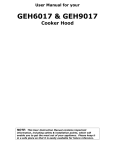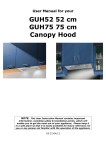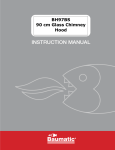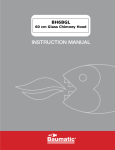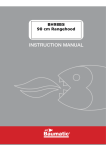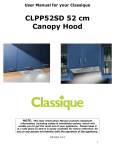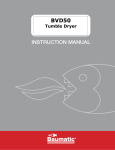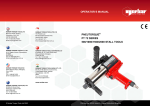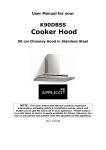Download Cooker Hood
Transcript
User Manual for your KEC60SS/KEC90SS Cooker Hood 60 cm Chimney Hood in Stainless Steel 90 cm Chimney Hood in Stainless Steel NOTE: This User Instruction Manual contains important information, including safety & installation points, which will enable you to get the most out of your appliance. Please keep it in a safe place so that it is easily available for future reference; for you or any person not familiar with the operation of the appliance. DD 11/03/08 Contents Page Environmental note 3 IMPORTANT SAFETY INFORMATION 4–6 Specifications of your cooker hood 7 Using your cooker hood 8 Cleaning your cooker hood The grease filter 9 Maintenance Removing and cleaning the grease filter Changing a light bulb Fitting the carbon filters 10 10 11 12 Installation Electrical connection Before beginning installation Installing your cooker hood Connecting to external ducting Fitting the chimney section 13 13 14 15 18 18 Extraction mode or recirculation mode? 21 Troubleshooting 22 conditions of guarantee Contact details – 14 – 15 – 17 – 19 23 24 1 ENVIRONMENTAL NOTE Note: Before discarding an old appliance, switch off and disconnect it from the power supply. Cut off and render any plug useless. Cut the cable off directly behind the appliance to prevent misuse. This should be undertaken by a competent person. CONFORMITY TO W.E.E.E. DIRECTIVE 2 IMPORTANT SAFETY INFORMATION Your safety is of the utmost importance to us. Please make sure that you read this instruction booklet before attempting to install or use the appliance. If you are unsure of any of information contained in this booklet, please contact the Technical Department. IMPORTANT: Any installation work must be carried out by a qualified electrician or competent person. o The hood must be installed in accordance with the installation instructions and all measurements followed. o If the cooker hood is installed for use above a gas appliance then the provision for ventilation must be in accordance with the Gas Safety Codes of Practice BS.6172, BS.5440 & BS.6891 (Natural Gas) and BS.5482 (LP Gas) 1994, the Gas Safety (Installation & Use) Regulations, the Building Regulations issued by the Department of the Environment, the Building Standards (Scotland) (Consolidated) Regulations issued by the Scottish Development Department. o It is dangerous to alter the specifications or to modify this product in any way. Do not tamper with it or attempt to modify the appliance in any way. o When installing the hood, ensure that the following recommended distances are being observed between the cooker top and the bottom of the cooker hood: ¾ Electric cookers: ¾ Gas cookers: ¾ Coal/ oil cookers: 700 mm 700 mm 800 mm IMPORTANT: DO NOT SET YOUR COOKER HOOD LESS THAN 700mm ABOVE YOUR COOKER. o When installed between adjoining wall cabinets, the cabinets must not overhang the hob. 3 o The edges of the cooker hood are sharp – be mindful of this as you handle your appliance, especially during installation and cleaning. DO NOT CLEAN IN BEHIND THE GREASE FILTERS! o If the room where the cooker hood is to be used contains a fuel burning appliance such as a central heating boiler then its flue must be of the sealed or balanced flue type. o If other types of flue or appliances are fitted, ensure that there is an adequate supply of air in the room. o When the hood is being used in its extractor function, ensure that the ducting is fire retardant and that there are no bends sharper than 90 degrees as this will reduce the efficiency of the hood. o Ensure the ducting for the extractor function has the same diameter as the outlet hole all the way through. o Keep young children from using, playing with or tampering with the cooker hood. Older children and infirm persons should be supervised if they are using the cooker hood. o Your cooker hood is for domestic use only. o Please dispose of the packing material carefully – children are especially vulnerable to it. o Dirty oil is an even greater fire risk. o Always put lids on pots and pans when cooking on a gas cooker. o The manufacturer refuses to accept any responsibility for damages arising to the hood or it catching on fire from failure to observe fire safety advice in these instructions. 4 o Remember that when in extraction mode, your cooker hood is removing air from your room. Ensure that proper ventilation measures are being observed. Note that it removes odours from your room, not steam. o Warning - Always ensure that the cooker hood has been disconnected from the power supply before carrying out any work on the hood, including replacing light bulbs. o Do not connect the ducting system of this appliance to any existing ventilation system which is being used for any other purpose. o Do not install above a cooker with a high level grill. o Never leave frying pans unattended during use as overheated fats and oils might catch fire. o Do not leave naked flames under the cooker hood. o Do not attempt to use the cooker hood if it is damaged in any way. Never attempt to use it without the grease filters fitted or if the filters are excessively greasy! o Never flambé cook under this cooker hood. THE MANUFACTURER DECLINES ALL RESPONSIBILITY IN THE EVENT OF FAILURE TO OBSERVE THE INSTRUCTIONS GIVEN HERE, FOR INSTALLATION, MAINTENANCE AND SUITABLE USE OF THE HOOD. 5 Specifications of your cooker hood Congratulations on purchasing a Cooker Hood! DIMENSIONS: KEC60SS Width Depth Height (canopy): (canopy): (with chimney) 600 mm 500 mm 680 mm – 1260 mm DIMENSIONS: KEC90SS Width Depth Height (canopy): (canopy): (with chimney) 900 mm 500 mm 680 mm – 1260 mm DIMENSIONS OF CHIMNEY SECTION: 300 mm x 280 mm Your stainless steel Cooker Hood is fitted with: o o o o o o High extraction tangential motor Push button control 3 Speeds 2 Metallic grease filters (KEC60SS only) 3 Metallic grease filters (KEC90SS only) 2 halogen lights Extraction capacity: Optional Extra: 700 m³/hr(KEC60SS ONLY) 1000 m3/hr(KEC90SS ONLY) 1 x S1 pair of carbon filters for air recirculation mode (available from the Spares Department). Using your cooker hood 6 1. Turn on the power; the buzzer will buzz five times. The sound shows that the appliance is powered. 2. Push the low button, the indicating light 1 on, the buzzer will buzz once, and the motor runs at low speed. Push it again and the motor will stop. 3. Push the middle button, the indicating light 2 on, the buzzer will buzz once, and the motor runs at mid speed. Push it again and the motor will stop 4. Push the high button, the indicating light 3 on, the buzzer will buzz once, and motor runs on high speed. Push it again and the motor will stop 5. Push the light button; the indicating light 4 on, and the two lighting lamps will come on. Push it again and the lamps will turn off, with every push the buzzer will buzz one time. IMPORTANT: IDEALLY YOU SHOULD TURN ON YOUR HOOD TEN MINUTES BEFORE YOU START TO COOK. OR AT THE VERY LEAST WHEN YOU BEGIN COOKING. YOU SHOULD ALSO RUN YOUR HOOD FOR TEN MINUTES AFTER YOU HAVE FINISHED COOKING. Cleaning your cooker hood 7 IMPORTANT: BEFORE CLEANING, ALWAYS ENSURE THAT YOU HAVE SWITCHED YOUR COOKER HOOD OFF AT THE OMNI-POLAR SWITCH, SET AT THE WALL FROM THE CABLE. Cleaning o Clean the external parts of your cooker hood with mild liquid detergent and a new damp cloth. o Never use abrasive powder, corrosive solvents or brushes. o Never insert pointed objects into the motor’s protective grid. o Only clean the control panel and grease filter grill with mild liquid detergents and a new damp cloth. o If you are using the appliance in recirculation mode, then be sure to replace the carbon filter at the recommended interval (see section on “Fitting the carbon filter”). A build up of grease could cause a fire hazard. o Never attempt to clean the area above the grease filters. The grease filter o Your cooker hood includes a grease filter which helps to absorb grease particles to protect your kitchen & furniture from greasy residues. o This metallic filter may become inflammable if it becomes saturated with this greasy residue. o To prevent this fire hazard, the filter should be cleaned regularly. Depending on use, this should be done every 10-15 days or at least once a month, using hot water and normal washing-up detergent. o DO NOT WASH THE GREASE FILTER IN A DISHWASHER. Maintenance Removing and cleaning the grease filter 8 o First remove the grease filter by pulling down on it. o Undo the side catches. o Soak the grease filter in hot water and washing up liquid for about an hour. o Rinse them off thoroughly with hot water. o Repeat the process if required. o Refit the grease filters once they have dried. o IMPORTANT: Let the grease filters dry thoroughly before refitting them in the cooker hood. Changing a light bulb 9 IMPORTANT: BEFORE ATTEMPTING TO CHANGE A LIGHT BULB, YOU MUST ENSURE THAT YOU HAVE DISCONNECTED THE COOKER HOOD FROM YOUR MAINS SUPPLY. o Remove the grease filters (as described on page 11). o Prior to touching the light bulbs ensure they are cooled down. o Find the bulb that requires replacement, you will find it located in the light fixture which is inside the exposed section of the canopy. o Unscrew the light bulb that needs to be replaced and insert a new G4 20W (max) bulb. o IMPORTANT: Defective bulbs should be replaced immediately. o If the lights still do not work, make sure that the lamps are fitted properly into their housings before you call for technical assistance. o Refit the grease filters. Fitting the carbon filter 10 If the appliance is being used to be used in recirculation mode then it is necessary to fit carbon filters. This will help to absorb unpleasant odours caused by cooking. IMPORTANT: BEFORE ATTEMPTING TO FIT OR REMOVE THE CARBON FILTERS, YOU MUST ENSURE THAT YOU HAVE DISCONNECTED THE COOKER HOOD FROM YOUR MAINS SUPPLY. 1) Remove the grease filters. 2) Hook the carbon filter over the pins that are located at the end of the motor. 3) Turn the carbon filter anticlockwise, until you feel it click into place. o Repeat this process for the second carbon filter. You need to place a carbon filter at either end of the motor. o Refit the grease filters. o The carbon filters should be replaced every three months or if they show signs of damage. Installation 11 IMPORTANT: Before installation and usage, read all the instructions and make sure that the voltage (V) and the frequency (Hz) indicated on the rating plate are exactly the same as the voltage and frequency in your home. The rating plate can be found behind the grease filters. The manufacturer declines all responsibility in the event of the installer failing to observe all the accident prevention regulations in force, which are necessary for normal use and the regular operation of the electric system. Electrical connection YOUR COOKER HOOD IS INTENDED FOR FITTED AND PERMANENT INSTALLATION. o The power cable must be connected to the terminals marked L (live) and N (neutral) in the hood and fixed with a cable clamp. o The cooker hood’s power cable must be fitted upstream from the electrical connection, using an omni-polar switch with a contact distance of at least 3 mm. WARNING: THIS APPLIANCE MUST BE EARTHED. It should only be connected by a competent person, using fixed wiring via a double pole switched fused spur outlet. (UK ONLY). We recommend that the appliance is connected by a qualified electrician, who is a member of the N.I.C.E.I.C. and who will comply with the I.E.E. and local regulations. The wires in the mains lead are coloured in accordance with the following UK code: Blue = Neutral, Brown = Live, Green/Yellow = Ground If you only find two wires in the main’s lead (blue and brown), then neither must be connected to the earth terminal. 12 o As the colours of the wires in the appliance’s mains lead may not correspond with the coloured markings identifying the terminals in your spur box, please proceed as follows: o The blue wire must be connected to the terminal marked “N” (neutral), or coloured black. o The brown wire must be connected to the terminal marked “L” (live), or coloured red. Before beginning installation o Check that the product purchased is of a suitable size for the chosen installation area. In addition check whether there is an electrical socket available that will be accessible once the hood is mounted. If the product is going to be used in extraction mode, then there should also be space to connect a ducting hose to the outside. o Carry out all necessary masonry work prior to the fitting of the cooker hood. o Ensure that all electrical connections are carried out by a suitably qualified person. o Before commencing installation of the cooker hood the grease filter should be removed. o Check inside the product and insure that there is no transit packaging or any other materials, such as packets of screws, guarantees etc. These should be removed and kept for future use. o If possible, disconnect and move freestanding or slot-in cookers from their position, to provide easier access to the rear wall and ceiling. If this is not possible, then a thick, protective covering should be placed over the worktop, hob top or cooker. This will help to protect these surfaces from damage and debris. o Select a flat surface for assembling the cooker hood. Cover that surface with a protective covering and place all cooker hood parts and fittings on it. o In addition check whether there is an electrical socket available, which will be accessible after the hood is mounted. If you are going to use the appliance in extractor mode, you should also 13 ensure that there is space to connect a fumes discharge device to the outside. o Raw plugs are provided to secure the hood to most types of walls and ceilings. However a qualified technician must verify the suitability of the materials, in accordance with the type of wall and ceiling. The wall and ceiling must be strong enough to take the weight of the hood. o Do not tile, grout or silicone this appliance to the wall. This appliance is designed to be surface mounted only. Installing your cooker hood IMPORTANT: YOU WILL HAVE TO DECIDE BEFORE INSTALLING YOUR COOKER HOOD WHETHER TO USE IT IN EXTRACTION MODE OR RECIRCULATION MODE. PLEASE TURN TO PAGE 22 NOW TO UNDERSTAND THE DIFFERENCES BETWEEN THESE TWO MODES. o The cooker hood should not be exposed to a direct heat source from the cooking device underneath it, i.e. naked flame from a gas burner or heat from electric hob zones without a pan on them. o We recommend that at least two people install this hood. o The lights on this appliance should only be used during operation of the cooker hood. They should not be left on permanently and used as a lighting source. IMPORTANT: YOUR COOKER HOOD SHOULD BE CONNECTED TO YOUR MAINS SUPPLY AFTER THE REST OF THE INSTALLATION PROCESS HAS BEEN COMPLETED. 1) Remove the metal grease filters. 14 2) Position the hood against the wall that you are intending to install it on and mark the position of the support holes that are to be drilled (as shown in the figure below). 2a) The support screw holes are indicated by figure A in this drawing and the anchoring screw holes are indicated by figure B. 3) Using a drill bit with a 8 mm diameter, make holes in the wall on the positions that you have marked in step 2. 15 4) Insert raw plugs into all of the holes that you have drilled. 5) Fasten the support screws halfway in, leaving them 10 mm out of the wall. 6) Hang the hood onto the support screws. 7) Fully tighten the support screws (A) and then screw the anchoring screws (B) through the relevant holes in the cooker hood. Tighten the anchoring screws fully into the wall 16 Connecting to external ducting 8) Connect the coupling to the top of the cooker hood, and then connect a 125 mm ducting hose to the coupling (please note that the ducting hose is not supplied with the appliance). o The other end of the ducting hose should be connected to your discharge outlet that is suitable for cooking vapours. It should have a cross section of at least 150 cm². o The maximum distance between the coupling and your discharge outlet should be 3 metres, with one 90 degree bend. Fitting the chimney 9) Take the two chimney sections (C and D). o Rest the bottom of chimney section C on the top of the hood. You should take care to position the tabs on the chimney section into the rear of the hood. o Mark the side measurement of both sides of chimney section C on the wall with a pencil. 17 10) Lift chimney section D upwards until it reaches the ceiling. You must ensure that it is perpendicular to the hood. o Mark the side measurement of both sides of chimney section D on the wall with a pencil and then remove chimney section D. 11) Take the fixing bracket (E) and place it between the two pencil marks that you made in step 9 o Keeping the bracket in contact with the wall, use a pencil to mark on the wall the anchoring holes that are cut out of the bracket 18 12) Using a 8 mm drill bit, drill out two holes on the pencil markings that you made in step 11. Insert raw plugs into the holes and then use a screwdriver to secure the fixing bracket to the wall. o Refit chimney section C to the hood and fix it onto the hood using the two screws that are supplied. o Secure the top of chimney section C to the fixing bracket, using the screws provided. o Slide chimney section D inside of chimney section C. Then secure the upper bracket to the wall, using the same method as you have just used to secure the lower bracket. 13) Lift chimney section D up to the ceiling and secure it to the fixing bracket using the screws provided. Electrical connection The electrical connection must correspond to the electrical requirement noted on the rating plate, which is placed inside the cooker hood. The appliance should be connected to the electrical supply. See page 14 – 15 for detailed information on the electrical connection. 19 Extraction mode or recirculation mode? What is the difference between extraction and recirculation modes? To get optimum performance from your cooker, the air will be taken out of the room via external ducting. Unfortunately if you live in a flat or the hood is too far from an outside wall, this may not be possible. The only alternative is to recirculate the air. In recirculation mode stale air is taken via the grease filter, and passed through a charcoal filter for purification. The air then re-enters the kitchen via an opening in the hood. What is a charcoal filter and do I need one? All cooker hoods have a grease filter but if you are using your cooker hood in recirculation mode, then a charcoal filter must be fitted in addition to the grease filter. 20 Troubleshooting IMPORTANT: If your cooker hood appears not to be operating properly, before contacting the Service Department, please refer to the checklist below. My cooker hood will not start. o Check that the hood is connected to the electricity supply o Check that the fan speed control is set correctly. My cooker hood is not working effectively. o The fan speed is not set high enough o The grease filter is dirty and requires cleaning. o The kitchen is not well ventilated enough. o If the hood is set up for recirculation mode, check that the carbon filters do not need replacing. o If the hood is set up for extraction mode, check that the ducting hose and discharge outlet are not blocked. My cooker hood has switched off during operation. o The safety cut-out device has been tripped. o Turn off the hob and then wait for the safety cut-out device to reset. o IMPORTANT: If you have installed your cooker hood too low, the safety cut-out device will frequently trip. Your cooker hood may become damaged if the safety cut-out device is tripped frequently. DO NOT MAKE ANY ATTEMPT TO REPAIR THE APPLIANCE YOURSELF. IF THE APPLIANCE IS STILL NOT OPERATING CORRECTLY, PLEASE CONTACT THE SERVICE DEPARTMENT ON TELEPHONE NUMBER (0118) 933 6911. 21 WARRANTY REGISTRATION CARD THIS WARRANTY IS VALID IN NEW ZEALAND ONLY Note: Please complete the following details when you unpack the product and return the bottom portion of this card to: Applico Ltd Private Bag 92-900 Onehunga Auckland, New Zealand Warranty: These products are covered by a warranty for a period of 24 months from the date of purchase, subject to the following conditions*. The Warranty covers rectification free of charge of any fault arising from defective materials or components, or faulty workmanship or assembly. * The conditions above mentioned are: 1. that the purchaser carefully follows all instructions packed with the product; 2. that the purchaser carefully follows the installation instructions provided and complies with electrical wiring regulations, gas and or plumbing codes; 3. that the purchaser carefully follows instructions provided in the owner’s handbook relating to the proper use and care of the product and does not use the product for any purpose other than the domestic use for which it has been designed; 4. all appliances being used in a non residential commercial situation are covered by a 3 month warranty from the original date of purchase; 5. that the product was purchased and installed in New Zealand; 6. that this warranty does not extend to: a) optional glass lids for hobs apart from claims which relate to mechanical or physical damage thereof at the date of purchase; b) light bulbs c) damage to ceramic glass caused by liquid or solid spillovers, lack of maintenance, or impact; d) damage to surface coatings caused by cleaning or maintenance using products not recommended by the owner’s handbook; e) defects caused by normal wear and tear, accident, negligence, alteration, misuse or incorrect installations; f) a product dismantled, repaired or serviced by any serviceman other than an authorised service agent; g) a product not in possession of the original purchaser; 7. that if the product is a microwave or small appliance it must be returned to the dealer for servicing. These products, unless stated otherwise have a 12 month warranty from original date of purchase with 24 months on the microwave magnetron; Waste disposers have a 24 month warranty; 8. The provision of service under this Warranty is limited by a 25km boundary from the retailer where the product was purchased. Such travelling outside of these limits will incur commercial cost to be paid by you, regulated by the number of kilometres travelled beyond the 25km limit (50km return trip). Nothing herein contained shall be construed in any way as excluding or limiting your rights under the Consumer Guarantees Acts 1993. For service please contact the dealer/retailer from whom you purchased the product. If you are unable to establish the date of purchase, or the fault is not covered by this Warranty, or if the product is found to be in working order, you will be required to bear all service call charges. Note: Completion of this Warranty Registration Card constitutes acceptance of the terms and conditions of this Warranty. Distributed by Applico Ltd www.applico.co.nz Please complete this section, detach and post to: Applico Warranty, Private Bag 92-900, Onehunga, Auckland or register online at www.applico.co.nz PRODUCT TYPE: ................................................. MODEL NO:................................................................... SERIAL NO: .......................................................... DATE OF PURCHASE: ................................................ RETAILER:............................................................ INVOICE/SALES DOCKET NO: ................................ RETAILER ADDRESS: ........................................................................................................................... PURCHASERS’ NAME: ...................................................................................................................... ADDRESS:........................................................................................................................................ PROCLAIM APL.AD.120 applico_warranty_card.indd 1 19/10/06 4:17:46 PM Affix stamp here Applico Ltd Warranty Department Private Bag 92-900 Onehunga Auckland applico_warranty_card.indd 2 19/10/06 4:17:46 PM

























